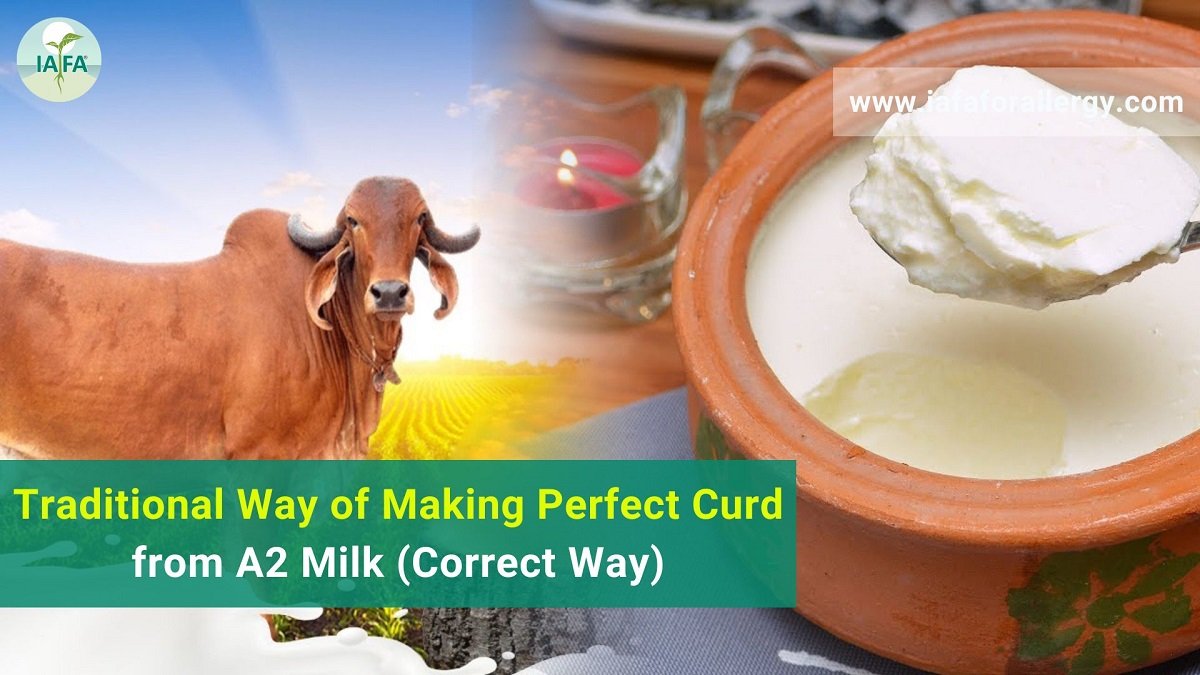Curd has been a part of our diet since the Vedic times. We end our meal with curd. Some even recommend eating curd in the morning with a spoon of sugar to calm our anxiety and anger.
Ayurveda considers curd as a probiotic which helps to absorb the nutrients fully. Curd is a powerhouse of many vital nutrients, vitamins and essential bacteria.
We can discuss the benefits of curd later, first, we will dive into the art of making perfect curd from A2 milk.
Synonyms of Curd
Dahi, Indian Yoghurt, Perugu, Tayir, Mosaru and Dahim.
Nutritional Information (100g Curd)
| Energy | 75kcal | FAT | 4.3g | |
| Protein | 11g | Carbohydrate | 3.4g | |
| Potassium | 4g | Sodium | 364g | |
| Calcium | 136g | Vitamin A | 2% | |
| Vitamin B12 | 6% | Magnesium | 5% |
How to Make Perfect Curd at Home? (Stepwise Guide)
1. Choose Milk:
Yes, we often get confused about which milk is the best to make curd that lingers its flavour on our younger for a long time. As per Ayurveda, the milk which is of:-
- Natural origin like A2 milk.
- No added preservatives
- Not genetically engineered
2. Boil the Milk:
Now that you know which is the best milk to make the perfect curd, the next thing is to boil the chosen milk.
While boiling the milk, you should keep in mind that the milk should not be over-boiled or under-boiled. It should be optimum. Boiling the milk nearer to 80°C is considered the best range as at this temperature all the bacteria which are competent with the yoghurt bacteria are killed. Ayurveda always recommends using an earthen pot, copper or brass utensil to cook the food or boil the milk. All are beneficial in their ways. You can choose the utensil at your convenience.
But, remember if you are using an earthen pot, it must be devoid of any glossy or paints used on it.
Things to Remember While Boiling the Milk:
- Under-boiling leaves the bacteria in the milk which may compete with lactic acid bacteria and diminishes the forming of curd.
- Over-boiling changes the taste of the milk which makes the curd lose its flavour.
These are the precautions you need to keep in mind while making Dahi at home.
Read – Traditional Method and Correct Way to Boil Milk
3. Let the Milk Cool:
Consider using a curd starter of A2 milk which is packed with more nutrients and devoid of artificially added chemicals. Once the milk is boiled, let it cool for some time. Do not add the starter to the hot milk. Let the milk cool down to around 40°C or just put your little finger in the milk to sense the lukewarm. Remember, milk should not be too hot or too cold. It should be lukewarm to make the perfect curd.
4. Add Curd Starter:
Always use a curd starter of A2 milk and make sure to have an earthen pot to make the perfect curd. You can feel the lukewarm milk and it’s the best time to add a curd starter. Take a teaspoon full of curd starter and add it to the lukewarm milk and stir the milk with that spoon.
Things to Remember after Adding the Starter:
- Close the earthen pot with the lid.
- Keep the earthen pot in a warm place like in the corner of your kitchen slab with the lid closed.
- Do not place it in a refrigerator.
- Do not shake it frequently until the curd is set.
5. Set It Aside:
After adding the curd starter, do not disturb the milk for some time. Set it aside for about 4-5 hours. It may take a little bit more time when it’s winter.
This is the traditional way of making perfect curd from A2 milk.
Quick Recipe Wrap-Up:
1. Ingredients Needed:
- Natural A2 milk.
- Curd starter of A2 milk.
2. Process:
- Choose natural A2 milk.
- Boil it optimally (no overheating or underheating).
- Let it cool down to lukewarm.
- Add a curd starter of A2 milk.
- Keep it aside undisturbed for a few hours.
- Enjoy the perfect curd with a long-lasting natural origin with no preservatives and artificial flavour.
Benefits of Curd made from A2 Milk
- It’s of natural origin and hence no chemicals.
- As a result, one can feel there are very less chances of intolerance after consuming this curd.
- Curd traditionally made from A2 milk is full of probiotics and prebiotics.
- Using an earthen pot enhances the rich flavour and nutrients of the curd.
Read – Cow Milk Allergy: Symptoms, Causes, Ayurvedic Reference, Do’s, Don’ts, Yoga in Cow Milk Allergy, Ayurvedic Treatment: Complete Ayurveda Details
Conclusion
Dr. Sahil Gupta, the founder of IAFA® not only treats his patients with the use of the ancient ayurvedic herbs but also takes due care by educating the people about the importance of Ayurveda and suggests his patients implement Ayurveda in their daily lives to prevent all kinds of allergies and wither diseases.









